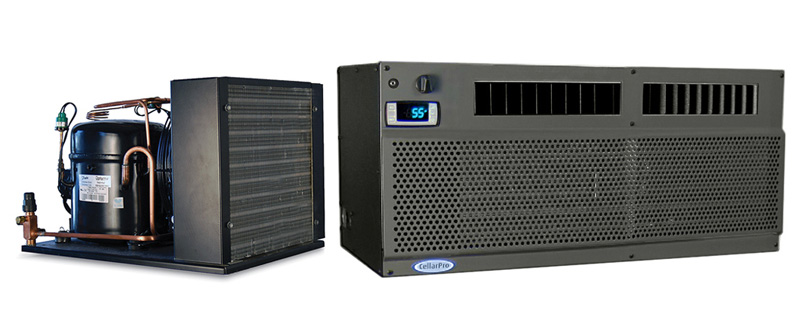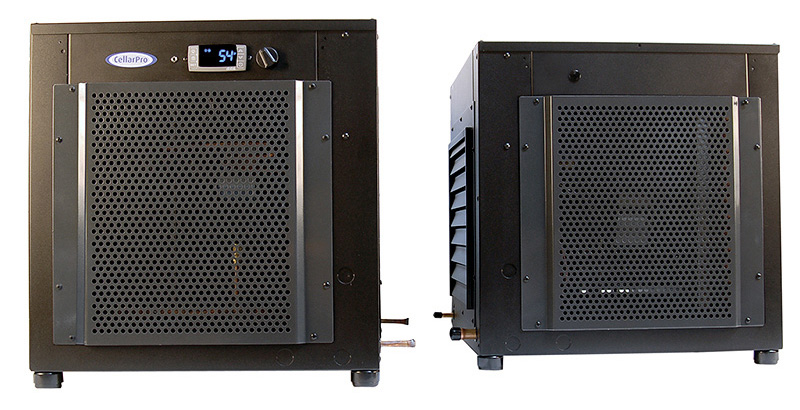
There are two types of split refrigeration systems used in wine cellars: conventional split systems and A/C split systems.
Conventional split systems are designed to maintain proper temperature and humidity conditions, A/C split systems cannot maintain ideal humidity levels inside wine cellars.

Conventional Split Systems
Conventional split refrigeration systems, like those made by CellarPro, are specifically designed for wine storage applications. They use condensing units with single-speed compressors and thermostatic expansion valves that are located in the evaporators, and are designed for use in wine cellars and wine storage applications.
In contrast, home air conditioning systems that are modified for use in wine cellars are called A/C split systems. Unlike conventional split systems, A/C split systems use variable-speed compressors and electronic expansion valves that are located in the condensing units.
A/C Split Systems
- A/C split systems consist of an outdoor air-cooled condensing unit matched with a single or multiple fan/coil evaporator units.
- These units use “Electronic” control (ie there is no liquid solenoid valve).
- These systems are pre-charged with refrigerant R-410A. Additional refrigerant is added depending on the length of the line-sets.
- The system is inverter controlled, automatically speeding up or slowing down the compressor and condenser fan to match the system capacity within a given capacity range.
- The evaporator fan is 3-speed, with automatic speed control and forward-curved centrifugal blowers.
- Because the expansion device is located in the condensing unit, the liquid line is actually a two-phase flow line, and must be insulated. These application rules are more complex and line run lengths are more limited compared to a conventional system.

Why A/C Split Systems are Not Optimal for Long Term Wine Storage
- A/C equipment is designed for both comfort cooling, (“latent cooling”), which removes moisture from the air, and “sensible cooling”, which reduces the temperature. In contrast, conventional split systems focus exclusively on sensible cooling, thus reducing temperature while removing as little moisture as possible. As a result, conventional splits are better equipped to maintain the ideal humidity conditions in side wine cellars.
- The catalog design limit for most A/C equipment is 67°F DB, which is significantly higher than the optimal wine storage conditions of 55°F DB. In most cases, A/C controllers cannot be set below 60°F, and therefore must be rewired and retrofitted to achieve desired wine storage temperatures. Under these circumstances, the manufacturer’s warranty may become void, forcing the customer to rely exclusivly on the HVAC installer for any/all recourse.
- After A/C split systems are retrofitted, the coil temperatures necessarily will operate below the manufacturer’s recommended minimum temperatures, and therefore will reduce coil temperatures below the cellar dew point. This is likely to result in frosted conditions, thereby extracting moisture from the room and reducing the cellar’s humidity below ideal levels.
- A/C split system compressor ratings are quoted for air conditioning applications, making it difficult to calculate the correct BTUH for wine storage applications. Therefore, contractors must engage in trial and error when sizing A/C split systems for wine cellars, as opposed to using proper engineering models and scientific data.
- Due to the complexities of the controller and the two-phase piping system, A/C split systems require a higher level of expertise and training than conventional split systems, thereby increasing installation and maintenance costs.
Before purchasing a split refrigeration system for your wine cellar, it is advisable to ask your contractor what kind of refrigeration equipment he intends to use.
If you don’t understand his answer, feel free to give us a call and we’ll be glad to help. Our toll-free number is 877.726.8496.
Are wall mount air conditioning evaporator fan coils (mitsubishi) used with refrigeration condensers?